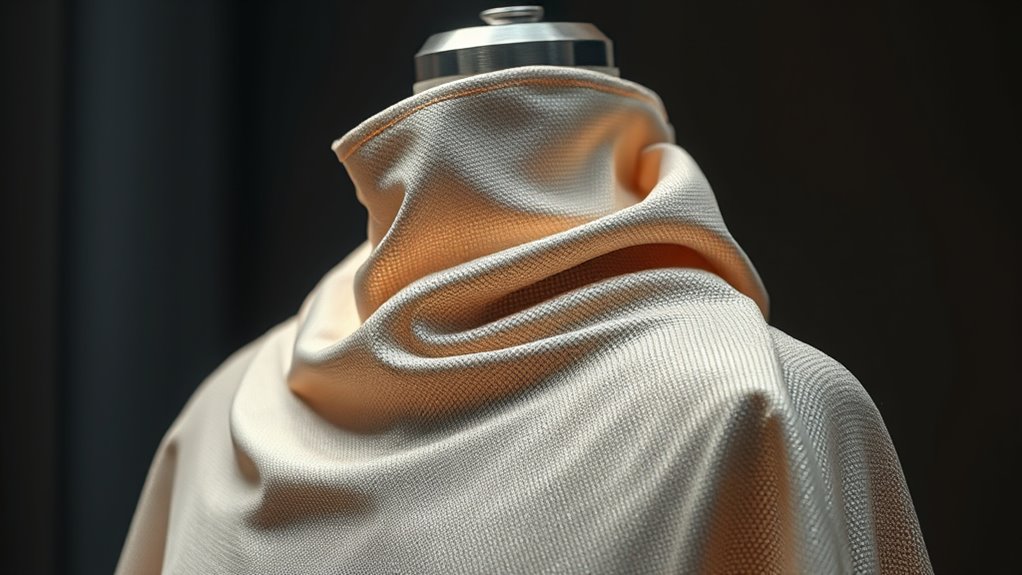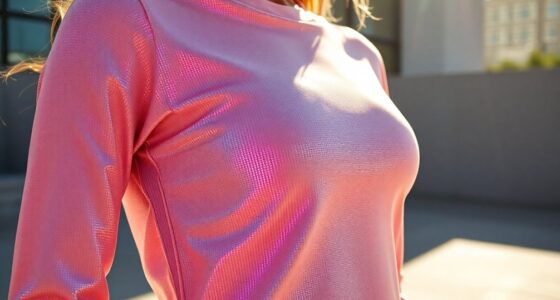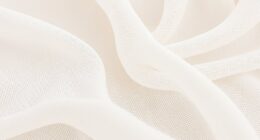Graphene-infused fabrics are ushering in a new era of “super clothes” by enhancing durability, comfort, and connectivity in your garments. These fabrics are stronger, more flexible, and capable of integrating wearable technology like sensors and energy generation features. This technology can make your clothing smarter, longer-lasting, and more adaptable to your needs. If you keep exploring, you’ll discover how these innovations could revolutionize your wardrobe and everyday life.
Key Takeaways
- Graphene-infused fabrics enhance durability, flexibility, and comfort, extending clothing lifespan and reducing waste.
- These textiles enable integration of wearable sensors for health monitoring and seamless digital interaction.
- They can generate small amounts of electricity, powering embedded devices and improving energy efficiency.
- The technology supports smarter, more multifunctional garments for medical, sports, and military uses.
- Overall, graphene fabrics are paving the way for “super clothes” that combine durability, technology, and sustainability.

Have you ever wondered how fabrics are evolving with cutting-edge technology? The answer lies in the exciting domain of graphene-infused fabrics, which are transforming the way you experience clothing. These innovative textiles are not just about style; they’re about pushing the boundaries of what fabrics can do. Graphene, a single layer of carbon atoms arranged in a hexagonal lattice, brings incredible properties to textiles, making them smarter, stronger, and more versatile. When integrated into fabrics, graphene enhances wearable technology, allowing your clothes to do more than just cover your body. Think of clothing that can monitor your health, adapt to your environment, or even generate energy. The potential is vast, and it’s happening now.
Discover how graphene-infused fabrics are revolutionizing clothing with smarter, stronger, and more versatile properties.
One of the most significant advantages of graphene-infused fabrics is their increased fabric durability. Traditional fabrics often wear out quickly, especially with frequent use and washing. But graphene’s exceptional strength and flexibility mean that these new textiles can withstand the rigors of daily life far better. They resist tearing, stretching, and other forms of damage, which prolongs the lifespan of your clothing. This durability doesn’t come at the expense of comfort, either. These fabrics remain lightweight, breathable, and comfortable while offering a toughness that was previously unimaginable in textiles. This resilience not only benefits consumers by reducing replacement costs but also promotes sustainable fashion by lowering waste.
In addition to durability, graphene’s conductive properties open a new world of wearable technology. Imagine clothes that can track your vital signs, adjust their thermal properties based on the weather, or even charge your devices on the go. The ability to embed sensors directly into the fabric creates a seamless interface between you and technology. You no longer need bulky gadgets or accessories; your shirt, jacket, or sportswear can become a functional extension of your digital life. This integration of wearable technology into everyday clothing makes your routines more efficient, healthier, and more connected.
Moreover, graphene-infused fabrics can also contribute to energy efficiency. For instance, they can generate small amounts of electricity through movement or thermal differences, powering embedded sensors or LED displays. This self-sustaining feature makes them ideal for outdoor activities or remote environments, where traditional power sources are limited. As research advances, expect to see these fabrics playing a pivotal role in sportswear, medical textiles, military gear, and advanced materials, blending durability with technological innovation.
Frequently Asked Questions
How Durable Are Graphene-Infused Fabrics Through Repeated Washing?
You might wonder how durable graphene-infused fabrics are through repeated washing. These fabrics generally offer good washing durability, maintaining fabric longevity when cared for properly. The graphene is integrated into the fibers, which helps prevent it from washing out easily. However, excessive or harsh washing can affect their performance over time. To maximize their durability, follow the manufacturer’s care instructions and avoid aggressive washing cycles.
Are Graphene Fabrics Safe for Sensitive Skin and Allergic Reactions?
You might wonder if graphene fabrics are safe for your skin, especially if you’re sensitive or concerned about allergies. Generally, these fabrics are designed to be biocompatible and hypoallergenic, but individual reactions can vary. It’s wise to verify for any skin sensitivity or allergy concerns before wearing them regularly. If you notice irritation or discomfort, discontinue use and consult a dermatologist to ensure your skin’s safety.
What Are the Environmental Impacts of Producing Graphene Textiles?
Imagine a delicate balance teetering on a thin wire—producing graphene textiles impacts the environment. Eco-friendly production methods and supply chain sustainability can reduce harmful emissions and resource depletion. However, the extraction and processing of graphene still pose challenges, like a storm gathering on the horizon. By prioritizing sustainable practices, you can help guarantee that the journey toward innovative fabrics doesn’t leave the planet scarred.
Can Graphene Fabrics Be Recycled or Composted After Use?
You might wonder if graphene fabrics can be recycled or composted after use. Recycling challenges arise because integrating graphene into textiles complicates the separation process, making recycling difficult. Additionally, biodegradability concerns mean these fabrics aren’t easily composted, as graphene’s durability can hinder natural decomposition. Overall, current technology limits eco-friendly disposal methods, so managing waste from graphene-infused textiles remains a significant environmental issue.
How Does the Cost of Graphene-Infused Clothing Compare to Conventional Textiles?
Think of graphene-infused clothing as rare gemstones in a sea of glass beads. The cost comparison reveals these super fabrics are pricier due to advanced manufacturing and materials. An affordability analysis shows they’re still a luxury for now, but as production scales up, prices could drop. You might pay more upfront, but the durability and tech benefits could make them worth the investment in the long run.
Conclusion
As you explore graphene-infused fabrics, it’s tempting to believe they’ll revolutionize clothing instantly. While the technology offers incredible potential—like enhanced strength, flexibility, and conductivity—research is still evolving. Some experts suggest we’re close to mainstream adoption, but others warn challenges remain. So, while super clothes may be on the horizon, don’t assume they’re here just yet. Keep an eye on ongoing innovations; the future of smart, durable fabrics might surprise you.









